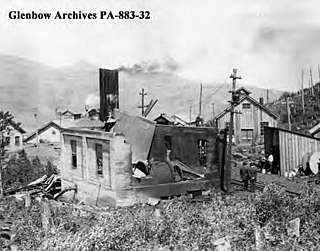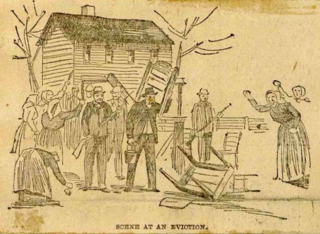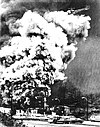A mining accident is an accident that occurs during the process of mining minerals or metals. Thousands of miners die from mining accidents each year, especially from underground coal mining, although accidents also occur in hard rock mining. Coal mining is considered much more hazardous than hard rock mining due to flat-lying rock strata, generally incompetent rock, the presence of methane gas, and coal dust. Most of the deaths these days occur in developing countries, and rural parts of developed countries where safety measures are not practiced as fully. A mining disaster is an incident where there are five or more fatalities.

The Monongah mining disaster of Monongah, West Virginia occurred on December 6, 1907, and has been described as "the worst mining disaster in American history." 362 miners were killed. The explosion occurred in Fairmont Coal Company’s No. 6 and No. 8 mines, and was one of the contributing events leading to the creation of the United States Bureau of Mines.

The Hillcrest mine disaster, the worst coal mining disaster in Canadian history, occurred at Hillcrest, Alberta, in the Crowsnest Pass region, on June 19, 1914, 9:30 am.

The Courrières mine disaster, Europe's worst mining accident, caused the death of 1,099 miners in Northern France on 10 March 1906. This disaster was surpassed only by the Benxihu Colliery accident in China on 26 April 1942, which killed 1,549 miners. A coaldust explosion, the cause of which is not known with certainty, devastated a coal mine operated by the Compagnie des mines de houille de Courrières. Victims lived nearby in the villages of Méricourt, Sallaumines, Billy-Montigny, and Noyelles-sous-Lens. The mine was 2 km (1 mi) to the east of Lens, in the Pas-de-Calais département.
The Castle Gate mine disaster occurred on March 8, 1924, in a coal mine near the town of Castle Gate, Utah, located approximately 90 miles southeast of Salt Lake City. All of the 171 men working in the mine were killed in the series of three violent explosions. One worker, the leader of the rescue crew, died from carbon monoxide inhalation while attempting to reach the victims shortly after the explosion.

Jacobs Creek is a 33.4-mile-long (53.8 km) tributary of the Youghiogheny River beginning in Acme, Pennsylvania and draining at its mouth in the town of Jacobs Creek into the Youghiogheny River. Jacobs Creek is the southwestern border of Westmoreland County and the northwestern border of Fayette County. The area was a major producer of rye whiskey in the decades before Prohibition.
The Pittsburgh Coalfield is the largest of the Western Pennsylvania coalfields. It includes all or part of Allegheny, Fayette, Greene, Washington, and Westmoreland Counties in Pennsylvania. Coal has been mined in Pittsburgh since the 18th century. U.S. Steel and Bethlehem Steel owned Karen, Maple Creek, and Ellsworth mines. It is not possible to define sharp geographical boundaries for this district for none such exist or are reported differently. The largest company in this field was the Pittsburgh Coal Company, which later became CONSOL Energy. It is bordered on the west by the state of West Virginia, on the south by Panhandle Coalfield and Klondike Coalfield, on the East by Irwin Gas Coalfield, on the North by the Freeport Coalfield and at least one other coalfield. The Darr Mine Disaster occurred in this coalfield in 1907.

The Cross Mountain Mine disaster was a coal mine explosion that occurred on December 9, 1911, near the community of Briceville, Tennessee, in the southeastern United States. In spite of a well-organized rescue effort led by the newly created Bureau of Mines, 84 miners died in the disaster. The cause of the explosion was the ignition of dust and methane gas released by a roof fall. Miners would use open oil lamps to provide a light source down in the mines.
The Minnie Pit disaster was a coal mining accident that took place on 12 January 1918 in Halmer End, Staffordshire, in which 155 men and boys died. The disaster, which was caused by an explosion due to firedamp, is the worst ever recorded in the North Staffordshire Coalfield. An official investigation never established what caused the ignition of flammable gases in the pit.
The Naomi Mine explosion occurred on December 1, 1907, in the Naomi Mine, approximately 2 miles (3.2 km) from Fayette City, Pennsylvania. The incident resulted in the deaths of at least 35 miners and left no survivors.

The 2009 Handlová mine blast occurred on 10 August 2009 roughly 330 metres (1,080 ft) underground in Trencin Region, Slovakia at Hornonitrianske Bane Prievidza, a.s.s (HNB) coal mine located in the town of Handlová. 20 people were killed, nine others suffered minor injuries and were taken to hospital for treatment. Some historians have called the disaster the largest mining tragedy in Slovakia’s history. The deadly explosion, probably caused by flammable gases, occurred after mine rescuers had earlier been deployed to extinguish a fire in the Eastern shaft of the mine.
The Benwood Mine Disaster was a coal mine explosion that occurred on Monday, April 28, 1924, at the Benwood Mine of the former Wheeling Steel Corporation steel mill located in the city of Benwood in Marshall County, West Virginia. The explosion claimed the lives of 119 coal miners. There were two survivors. It is the third worst coal mining disaster in the state of West Virginia after the Monongah Mine disaster of December 6, 1907 that claimed the lives of 361 miners and the Eccles Mine Disaster of April 28, 1914 that claimed the lives of 183 miners.
The Harwick Mine disaster was a mining accident on January 25, 1904 in Cheswick, Pennsylvania, some sixteen mi (26 km) north of Pittsburgh in the western part of the state. The blast killed an estimated 179 miners and 2 aid workers. The disaster ranks among the ten worst coal mining disasters in American history. One community especially impacted was the Hungarian community in Homestead, Pennsylvania. Fifty-eight of the members of the First Hungarian Reformed Church of Homestead—a full third of the congregation—died in the explosion.
Hazel Kirk is an unincorporated community and coal town located in Washington County, in the southwestern corner of the U.S. state of Pennsylvania. Hazel Kirk was part of Carroll Township and was the location of four bituminous coal mines, known as "Hazel Kirk Mine," "Hazel Kirk No. 1," "Hazel Kirk No. 2," and "Hazel Kirk No. 3."

The Morewood massacre was an armed labor-union conflict in Morewood, Pennsylvania, in Westmoreland County, west of the present-day borough Mount Pleasant in 1891.
Mammoth is a census-designated place that is located in Mount Pleasant Township, Westmoreland County in the state of Pennsylvania, United States, with its own post office and postal zip code: 15664.
The Baltimore Mine Tunnel disaster was an explosion that occurred on June 5, 1919 just inside the mouth of Baltimore Tunnel No. 2. The Delaware and Hudson Coal Company's mine employed 450 workers and was located in Wilkes-Barre, Pennsylvania, about a mile from the center of the city near the modern day corner of North Sherman, Spring, and Pine Streets. Ninety-two miners were killed and 44 injured in the explosion, which was caused by the ignition of black blasting powder. Only 7 miners escaped without injury.

The Mammoth Mine disaster or Frick Mine explosion occurred on January 27, 1891 just after 9:00 AM in the Mammoth No. 1 mine in Mount Pleasant Township, Westmoreland County, Pennsylvania. Newspapers reported that firedamp was ignited by a miner's oil lamp, resulting in the deaths of 109 men and boys. Most of the miners were not killed by the force of the explosion, but rather were suffocated by the effects of afterdamp.
Jacobs Creek is an unincorporated community in Westmoreland County, Pennsylvania, United States. The community is located at the mouth of Jacobs Creek on the Youghiogheny River, 1.5 miles (2.4 km) south of Smithton. Jacobs Creek has a post office with ZIP code 15448, which opened on December 14, 1865.
The Marianna Coal Mine disaster, in Marianna, Pennsylvania, killed 154 miners and left one survivor on November 28, 1908, in what was the worst disaster in Washington County history. The incident, and several others at the time, catalyzed public advocacy for mine safety, leading to the establishment of the US Bureau of Mines in 1910. USBM research on safer blasting material and the prevention of mine gas and dust explosions resulted in reduced occurrence of mine disasters.










